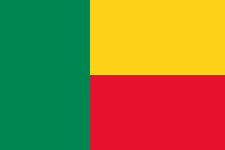LANDRY CYRILLE BANKOLE
09/2010 – 11/2014 – St-Etienne, France
Safety and Effectiveness of Home-Based Exercise Therapy in Facioscapulohumeral Muscular Dystrophy (Co-Supervisor – Principal Supervisor: Pr Léonard Féasson)

Biography

Dr. Cyrille Bankolé, PhD, graduated from the University of Saint Etienne (France) in Biology and physiology of exercise in 2014. In 2009, he obtained a swedish research grant and developed at the lab of School of Health Sciences, the basics of muscle regeneration and satellite cells. From 2011 to 2014, he obtained a research grant from the French Muscular Dystrophy Association (AFM-Téléthon) and worked as a researcher on an international and multifactorial research project entitled « Exercise Therapy in Fascioscapulahumeral dystrophy ». In 2015, he moved to Canada to improve his English. Currently, he holds teaching positions in different institutions (Secondary school, college and university) in Ontario, Canada. He is currently undertaking a practical exam to become a Certified Exercise Physiologist (CEP) of the Canadian Society for Exercise Physiology.
His research focus is a crossroad of physiology and biology to better understand the structural, metabolic and functional adaptations of muscles subjected to environmental changes and stimuli such as physical activity in various populations. He is proficient in functional assessments such as cardio respiratory, neuromuscular function and muscle biology assessment such as structural muscle analysis, muscle regeneration, and mitochondrial respiration. He also mastered the use of cycle and arm ergometers, treadmill, metabolic analysers, pulmonary function systems, various body composition assessment methodologies, manual and tonometric blood pressure monitoring equipment, blood analysis, femoral nerve magnetic stimulation and isokinetic dynamometry. In addition, he has gained a strong expertise in muscle regeneration through the study of satellite cells, especially the biological mechanisms behind the development of satellite cells based on physical activity. Furthermore, he has dedicated a part of his research to understanding and treating fatigue in clinical populations.
As of June 2020, he has published 5 journal articles. He has supervised 5 graduated students and he he has presented at ~25 national and international congresses and conferences
Cyrille Bankolé has practiced various sports in competition for 20 years. Specifically, he played for the French youth soccer national team, and was a 2-time national youth champion for the 100 m race and the long jump.
Main results of the work we have done together
- Safety and efficacy of a 6-month home-based exercise program in patients with facioscapulohumeral muscular dystrophy: A randomized controlled trial: Sixteen FSHD patients randomly assigned to training (TG) and control (CG) groups (both n = 8) in a home-based exercise intervention. Training consisted of cycling 3 times weekly for 35 minutes (combination of strength, high-intensity interval, and low-intensity aerobic) at home for 24 weeks. Patients in CG also performed an identical training program (CTG) after 24 weeks. The outcomes showed that the compliance rate was 91% in TG. Significant improvements with training were observed in the VO2 peak (+19%, P = 0.002) and MAP by week 6 and further to week 24. Muscle endurance, MVC, and 6-minute walking distance increased and experienced fatigue decreased. Muscle fiber cross-sectional area and citrate synthase activity increased by 34% (P = 0.008) and 46% (P = 0.003), respectively. Dystrophic pathophysiologic patterns were not exacerbated. Similar improvements were experienced by TG and CTG.
- Assessment of quadriceps strength, endurance and fatigue in FSHD and CMT: Benefits and limits of femoral nerve magnetic stimulation: Nineteen FSHD patients (chromosome 4 linked) and eight CMT (type IA) patients with confirmed genetic diagnosis and twenty-three healthy controls volunteered to participate in this study (i) to evaluate the feasibility and the reliability of a test assessing quadriceps strength, endurance and fatigue in patients with facioscapulohumeral dystrophy (FSHD) and Charcot-Marie-Tooth disease (CMT), (ii) compare quadriceps function between patients and healthy controls. Controls and patients performed respectively one and twice the physical test which consisted to execute sets of 10 isometric contractions each followed by neuromuscular assessments with FNMS. Results showed that volitional assessment of muscle strength, endurance and fatigue appeared to be reliable in FSHD and CMT patients. Supramaximal FNMS was achieved in 70% of FSHD patients and in no CMT patients. In FSHD patients, Femoral nerve magnetic stimulation (FNMS) provided reliable assessment of central (typical error as a coefficient of variation (CVTE) < 8% for voluntary activation) and peripheral (CVTE < 10% and intraclass coefficient correlation >0.85 for evoked responses) function. Patients and controls had similar reductions in evoked quadriceps responses, voluntary activation and similar endurance. In conclusions, this test provides reliable evaluation but FNMS exhibits limitations due to insufficient stimulation intensity particularly in neurogenic conditions. It showed similar central and peripheral quadriceps fatigability in patients and controls.
Main publications associated with this work
Landry-Cyrille Bankolé, Guillaume Y. Millet, John Temesi, Damien Bachasson, Marion Ravelojaona, Bernard Wuyam, Samuel Verges, PhD,Elodie Ponsot, Jean-Christophe Antoine, Fawzi Kadi, Léonard Féasson. Safety and efficacy of a 6-month supervised and home-based exercise program in individuals with facioscapulohumeral muscular dystrophy (FSHD): A Randomized Controlled Trial. Medecine.2016 Aug.
Damien Bachasson, John Temesi , Landry-Cyrille Bankolé, , E Lagrange, Célia Boutte, Guillaume Y. MilletG Y Millet, Samuel Verges, Patrick A. Levy, L Léonard Féasson, Bernard Wuyam. Assessment of Quadriceps strength, endurance and fatigue in FSHD and CMT: benefits and limits of femoral nerve magnetic stimulation. Clin Neurophysiol. 2014 Feb.
